Venice, a Project to Be Curated. Alma Zevi and Aurora Fonda on Contemporary Art in the Lagoon and the Future.
September 30, 2020. Alma Zevi Gallery’s studio, Salizzada San Samuele 3355, Venice
Words by Claudia Malfitano
Images by Camilla Rigo Langé
Venice is like a cozy living room where it is still possible to run into each other and talk. But often the narrow alleys become suddenly crowded, and too many voices cover our words.
Now that the silence is almost unsettling, two gallerists Aurora Fonda of a plus a gallery and Alma Zevi meet in an apartment that used to be rented by tourists and now acts as studio to Alma Zevi’s gallery. It is an intimate artists’ residency and a great place to talk about art and Venice.
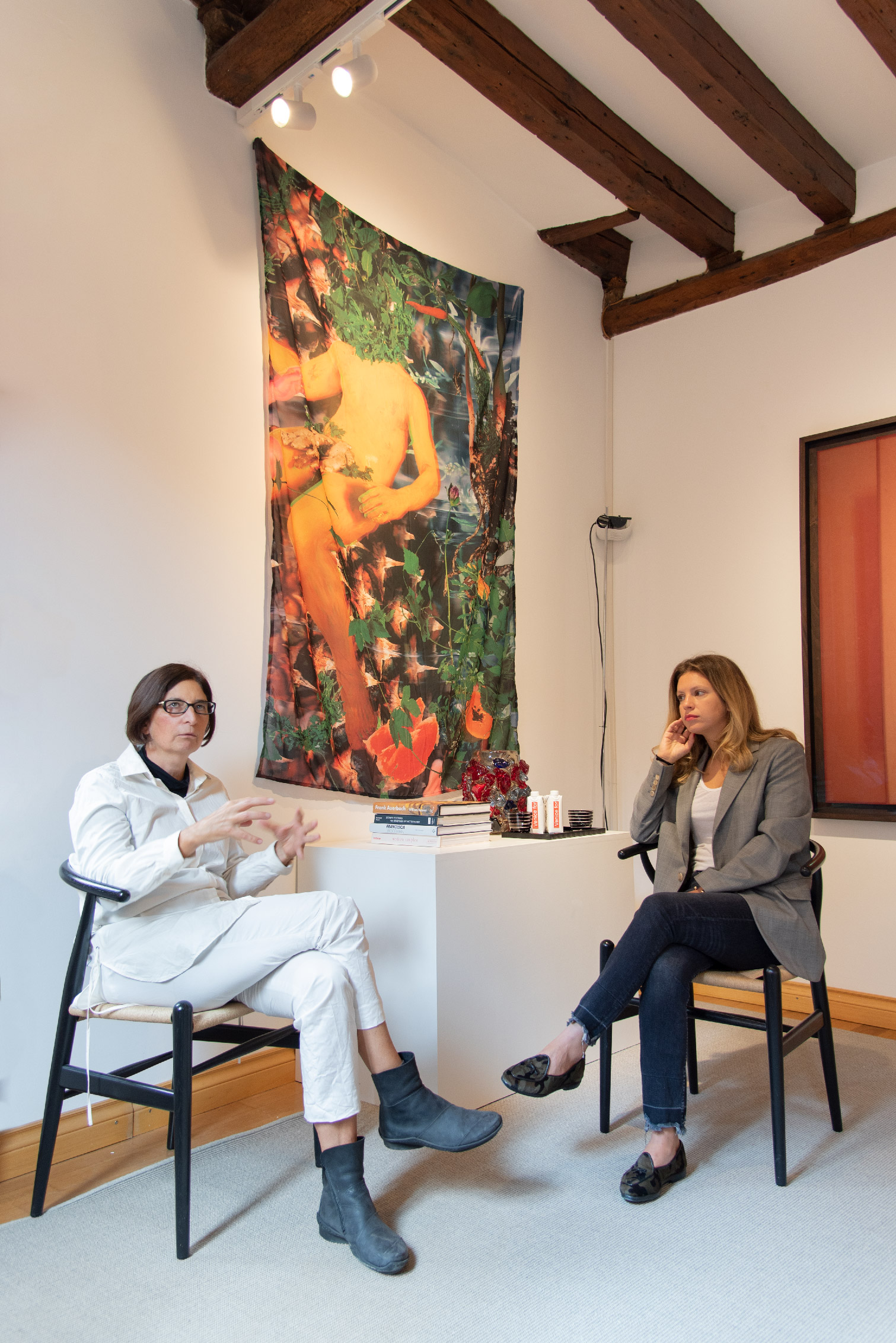

Above left: Aurora Fonda and Alma Zevi
Above right: detail of Aurora Fonda
How we got here.
Aurora Fonda: I came to Venice to study art history, I graduated from Ca’ Foscari with a thesis on Antonin Artaud and his drawings and then I started working as a freelance curator, curating exhibitions in Italy and abroad. I was at Fabrica the experimental school of Benetton, for a year, collaborating with Adam Broomberg with whom I created the “Fear” project as I have always liked to operate in the external and alternative spaces of the city: we intervened on the vaporetto stops and built an image path of what were the greatest fears of the 90s; and in 2003 I was asked to direct the Slovenian gallery here in Venice, the Slovenian pavilion at the Biennale. In 2014 Slovenia decided to go to the Arsenale, then with Sandro Pignotti, my partner, we decided to take over the space that is now an art gallery; since we have a school for curators and given our training – he has a Ph.D. in Philosophy and Literature and I in Art History – we try to do projects that have a strong curatorial imprint. So we collaborate with both Italian and international artists and curators with whom we try to structure projects designed for the gallery in a close or constant dialogue that leads us to build the exhibition.
Alma Zevi: In my case, I’ve been here since 2016. I studied Art History in London at the Courtauld Institute and then worked as an independent curator with different galleries and museums, and ofter had the chance to collaborate with artists. At one point I decided to come to Venice, and only after that I thought about what I could do here… so Venice brought me to Venice! In previous years I used to come quite often for the Biennale and I have always seen many beautiful restaurants, shops, and museums… but when someone asked me: “Where do we go to see a gallery?” I didn’t know what to say because there weren’t so many. So for me opening a gallery became an option. So I moved to Venice, and I particularly liked this area because there is your gallery, that of Giorgio Mastinu, Palazzo Grassi, and various pavilions of the Biennale – Bosnia, Luxembourg, Montenegro. I looked for a space in this area and started a program that included young artists, to alternate with more well-known artists. All of this was almost 5 years ago, and we’re still here! I too have made your same transition from art historian and curator to gallerist. Then among our activities, we also tried to add to our programming things that other galleries do not do, for example, artist residencies: the apartment where we are now, we usually use it as a studio for artists when they come to Venice for the residency. I wanted the gallery to have different functions, as you do with the school, for example. We must find new ways, we cannot remain anchored in the past.
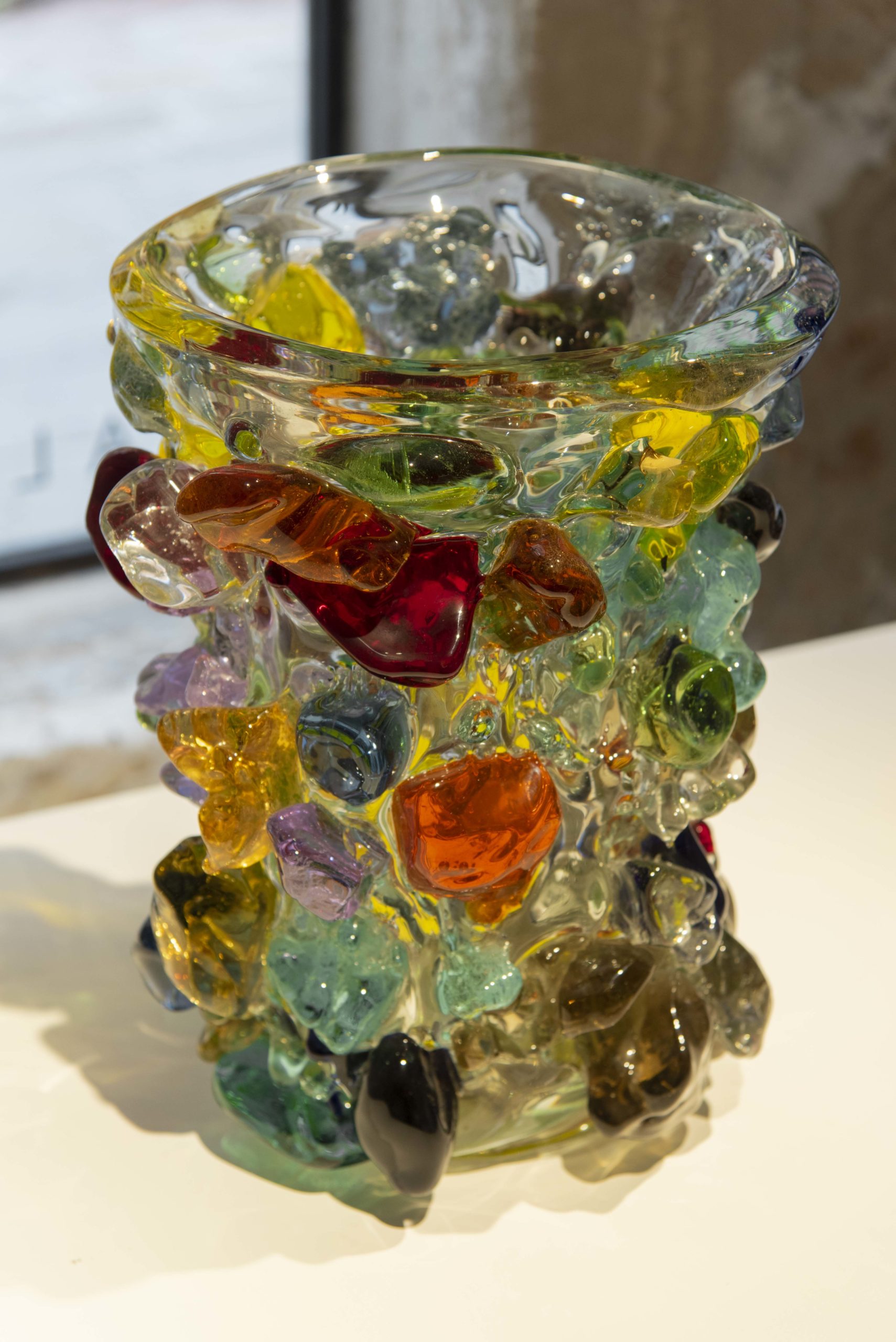
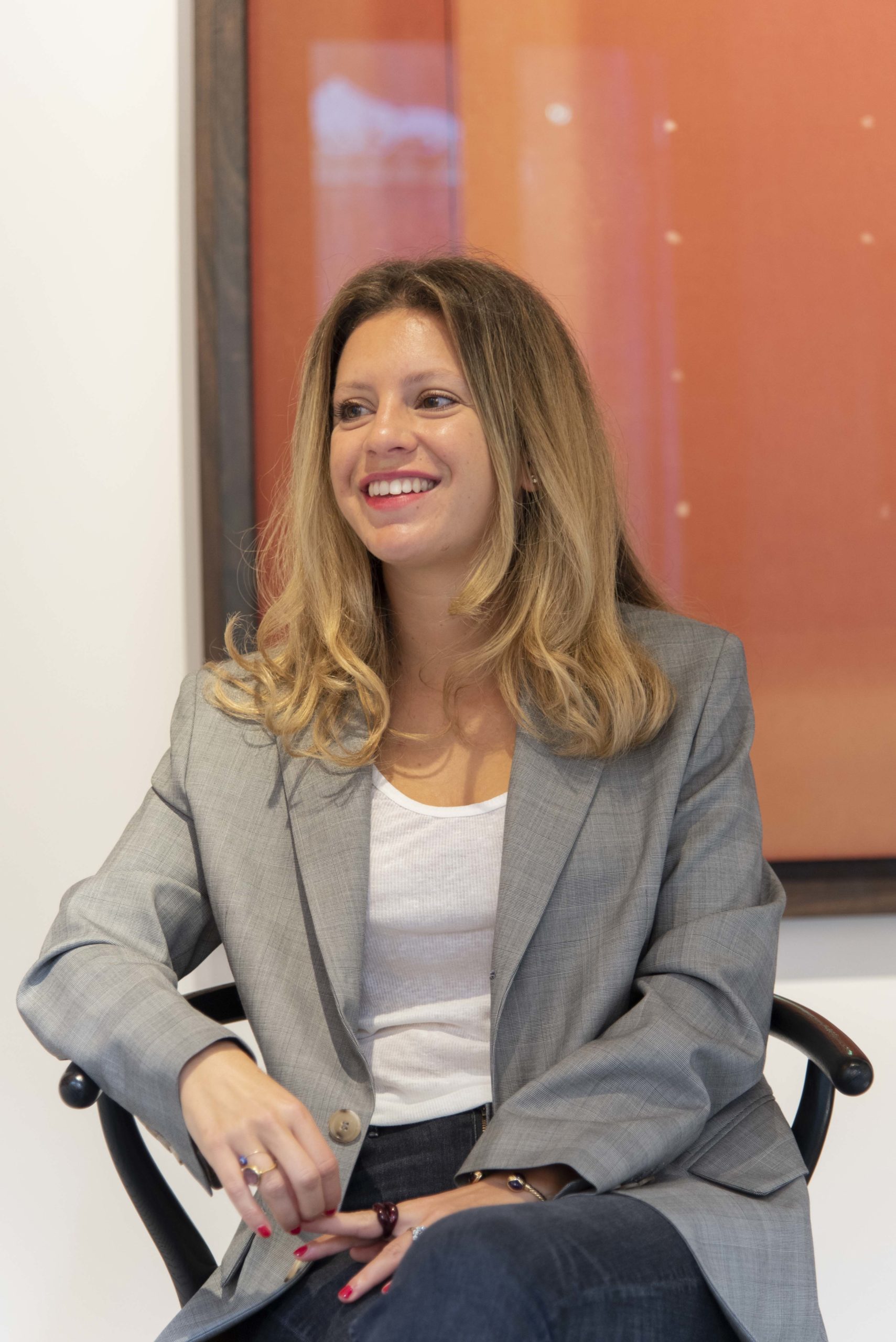
Above left: a work by Marcantonio Brandolini d’Adda, artist represented by Alma Zevi
Above right: Alma Zevi
Alma Zevi is a curator and gallerist, having organised over 30 exhibitions worldwide. Alma Zevi was born in London in 1988. She completed a degree in History of Art at the Courtauld Institute of Art in London in 2010. She lives between Venice and Celerina (Switzerland). Exhibition locations have included London, Venice, Vienna, Cologne, New York, Athens and Geneva. Zevi has curated exhibitions for national museums and institutions, such as The Museo d’Arte di Mendrisio and the Musee d’art e d’histoire in Geneva.
Alma Zevi founded her eponymous gallery in Venice, in 2016. The gallery’s mission is to provide a dynamic platform for both international emerging and established artists. The gallery regularly hosts artist residencies where new bodies of work are produced in response to the city’s unique cultural heritage. Central to the gallery’s ethos is the artist residency and project space that Alma founded in the mountain village of Celerina, Switzerland in 2013. In January 2019, Alma opened an outpost of the gallery in Mayfair, at the centre of London’s gallery district. This space, which serves as an office and private viewing room, further represents the gallery’s programme. Alma is a member of the Chinati Contemporary Council; the Warburg Visionary Circle; she is also a Young Patron of several prominent museums in the UK, including the Serpentine Gallery, and Victoria and Albert Museum. She has spoken at the Courtauld Institute, Oxford University, PhotoLondon, Somerset House and Serpentine Gallery.
Aurora Fonda: I agree, the gallery cannot and must not be a simple shop; and I believe that a form of research, such as an artist residency, following artists closely can make the difference.
Alma Zevi: And since our galleries are open almost 365 days a year, they both have an annual program and are not limited to certain periods. So it’s nice that you can do the Curatorial School and I can do the Artist Residency, which can go on as well during the low season of the year when the city is beautiful and the artists can explore it and understand many things that are impossible to understand in other moments… Time and space change… We must take advantage of this opportunity to stay in Venice, throughout the year.
Aurora Fonda: I think it is important to see that Venice has a cultural offer that is not exclusively linked to the Biennale. And if unfortunately this year the Biennale was suspended due to COVID, fortunately, numerous culturally active realities are emerging.
Alma Zevi: I find that Teatrino di Palazzo Grassi also has a nice program of events all year round, now for example they are presenting “Lo Schermo dell’Arte”. They offer great programming even in quieter moments, always giving both tourists and Venetians something interesting to do.
Aurora Fonda: Exactly! It would also be important to be able to create interest around the events, perhaps with organized visits to the artist’s studios. Despite how high rents are in Venice, there is no shortage of artists’ ateliers… among the younger ones there is Maddalena Tesser, then the generation of Maria Morganti, Elisabetta di Maggio, Maria Teresa Sartori…
Alma Zevi: …in Giudecca Carolina Antich, then there are young artists such as Marcantonio Brandolini d’Adda and Simone Carraro, who we currently have on display in the gallery. In particular, Simone was assigned one of the ateliers of the Bevilacqua La Masa Foundation last year. In addition, there is Giorgio Andreotta Calò who lives between Bologna and Venice… there is a whole life made of artists here in Venice.
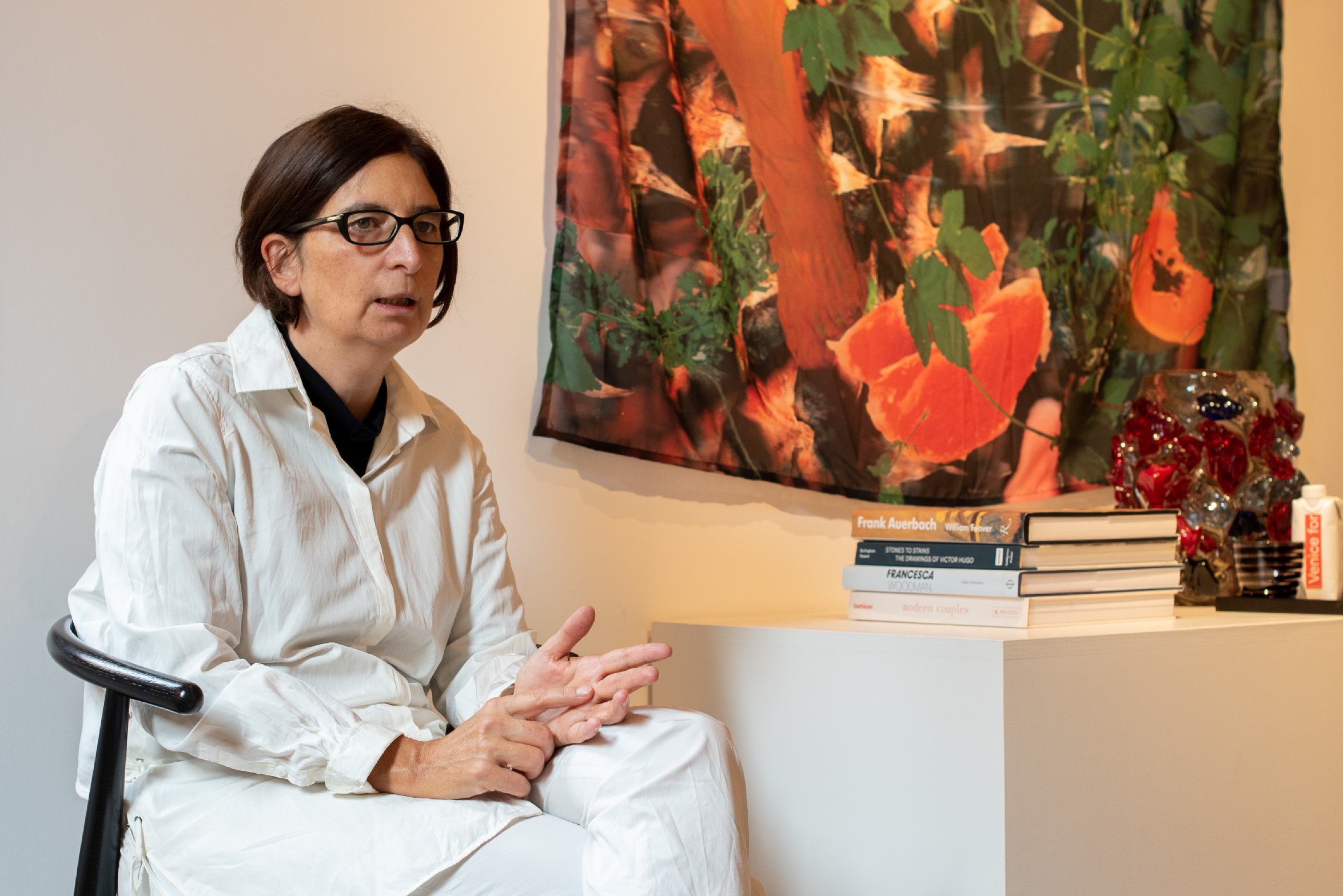
Above left: Aurora Fonda
Aurora Fonda was born in Slovenia and lives and works in Venice. Ph.D. in art history at the University of Padua, since 2003 she has directed the A plus A gallery in Venice, and in 2004, together with Sandro Pignotti, founded the School for Curatorial Studies Venice, a place for experimentation and research in the field of art contemporary and curating. An aspect that has a decisive influence on the exhibition policy of the A plus A gallery which has become private since 2015.
She has curated numerous exhibitions of young authors and established Italian and international artists such as Zoran Music, Jannis Kounnelis, Enzo Cucchi, Matej Andraz Vogrincic’s Casa Vestita. In 2001 and 2015 she was curator of the Slovenian pavilion at the Venice Biennale.
Contemporary art in Venice and Venice as a city.
Aurora Fonda: A greater proliferation of artistic activities could create a more lively situation in the city… perhaps associated with good promotion, this could bring benefits to the city. The level of cultural activity should also aim to higher goals, and by doing so perhaps we could reach a different audience even during the winter when the city is beautiful. And this would also benefit local artists who work in this context.
Alma Zevi: I also found exciting that throughout the year there are people who come to Venice and are interested in contemporary art and, since the city is small and there are not many galleries, they also have the opportunity to establish a more meaningful relationship with those who come to visit. To make a comparison, we are not for example in Chelsea, New York, where people arrive and find themselves in the total stress of having 20 galleries to see… when they are here, they come to me, they go to your gallery, they go to Giorgio Mastinu, to Palazzo Grassi, it’s a whole other pace thanks to which people can appreciate art and have a conversation with the gallerists. There is a value in this less hectic mode, it is another experience: it’s Venice. People come to Venice and are all happy, with a smile on their face. For me, this is the thing that most differentiates having a gallery here from the rest of the world. With Victoria Miro, for example, we are lucky to have such a good relationship, and their programming is of great quality. However, if we go back in time, once there were many more important galleries in the city, such as Capricorno, Cavallino, etc. The city should aspire to return to that point again, so Venice will be recognized not only for the Biennale but also for the programming of contemporary art galleries: this happens if you have a busy program connected to what is happening in the world and if you have a vision.
Aurora Fonda: Having a vision, exactly. The vision is the base on which a gallery should develop, in fact, it is not enough to make exhibitions, but in building the events and the next steps of an exhibition space one must always keep in mind and work to support and develop one’s vision. You would think this process is taken for granted, but in reality, it isn’t. And it is no coincidence, in fact, that today we only remember the work done by a gallery like Cavallino.
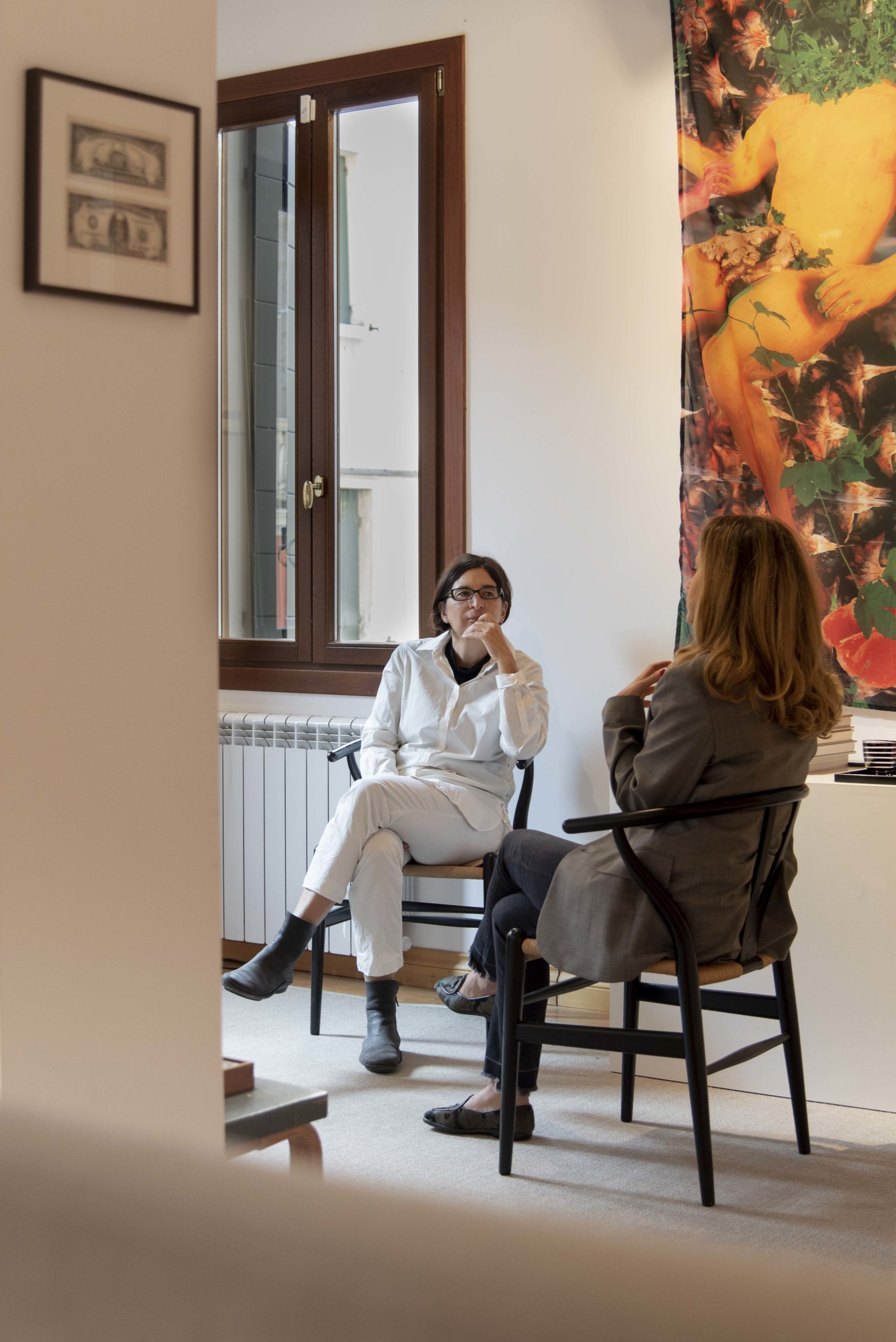
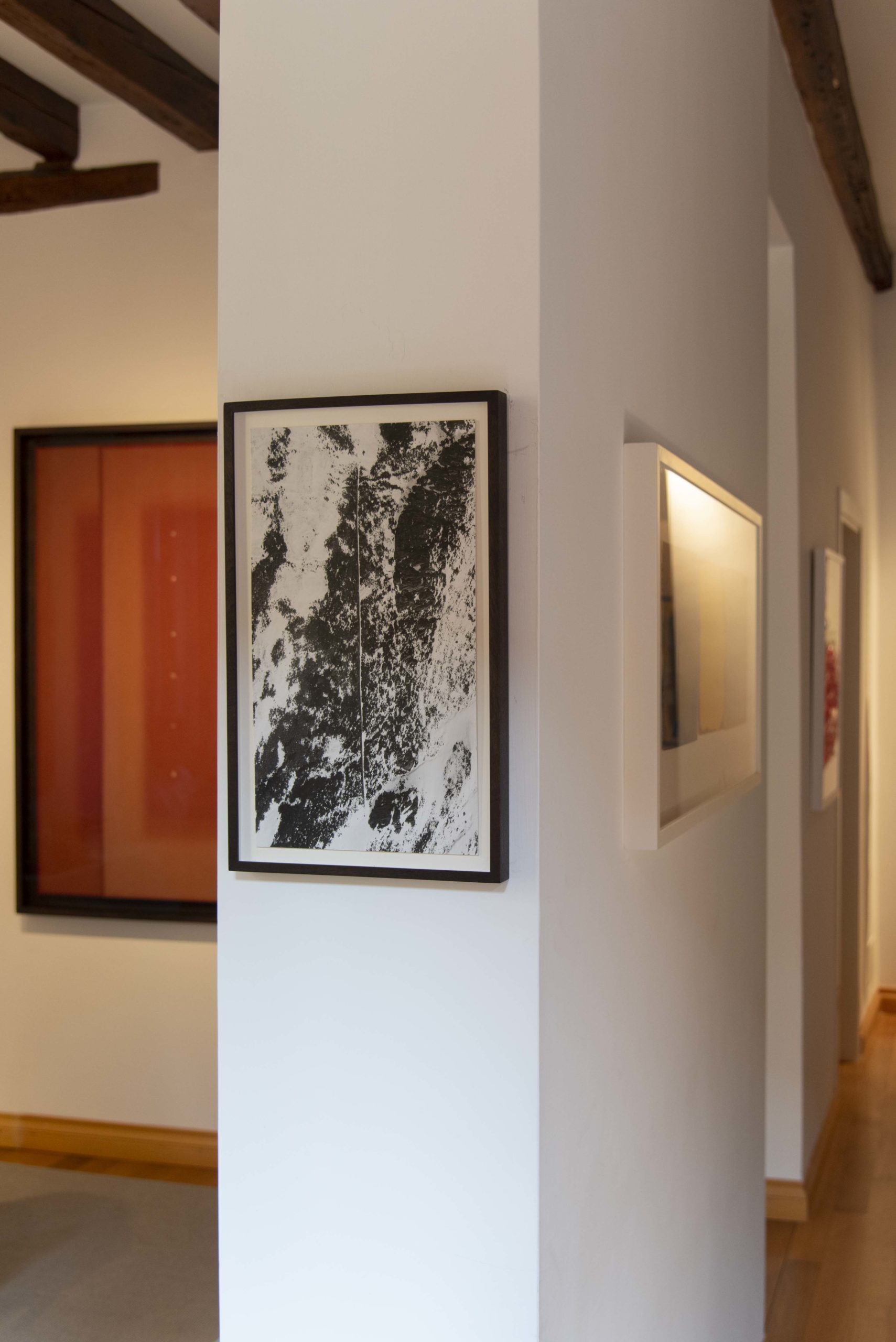
Above left: Aurora Fonda and Alma Zevi
Above right: detail of Alma Zevi’s viewing rooms
What Venice needs today.
Alma Zevi: Venice today needs more young people: more support for young artists and professionals. More initiatives for people who graduate, because if there is nothing for them here in Venice, they will obviously go to other cities. So, more opportunities. I see many empty buildings: I wonder why they don’t invest a little by giving them to those who want to do artist residency projects, but also recording studios, graphic design studios, film productions… with a small effort you could create something more attractive to young people.
Aurora Fonda: I absolutely agree: just think of the spaces of the Arsenale which are often rented only during the Biennale and remain empty for the rest of the year. These could be fantastic ateliers for artists, designers, or professionals of other disciplines, encouraging economies that are not essentially related to tourism. Among other things, these could become potential new residents.
Alma Zevi: The interesting thing about COVID is that with fewer tourists and Airbnb reservations, there are more opportunities for people who want to live in Venice, and who would have been forced to go to the mainland before. Now there is more space. Communication is also very important and I think it should improve for many young businesses, creative and not creative: having a good website, a good Instagram profile, are things that don’t cost much and everyone can do. Obviously, not everyone can come to Venice, but with a nice Instagram profile or a well-made website, you can create a connection between the city and the rest of the world. If someone is in Los Angeles and follows a beautiful Instagram profile for three years, they surely want to come to Italy and Venice! So in the long run, digital communication can have a positive effect even if you can’t travel as much now.
Aurora Fonda: …yes, it can create expectations, stimulate interest…
Alma Zevi: …we can’t stay in our bubble, we have to share…
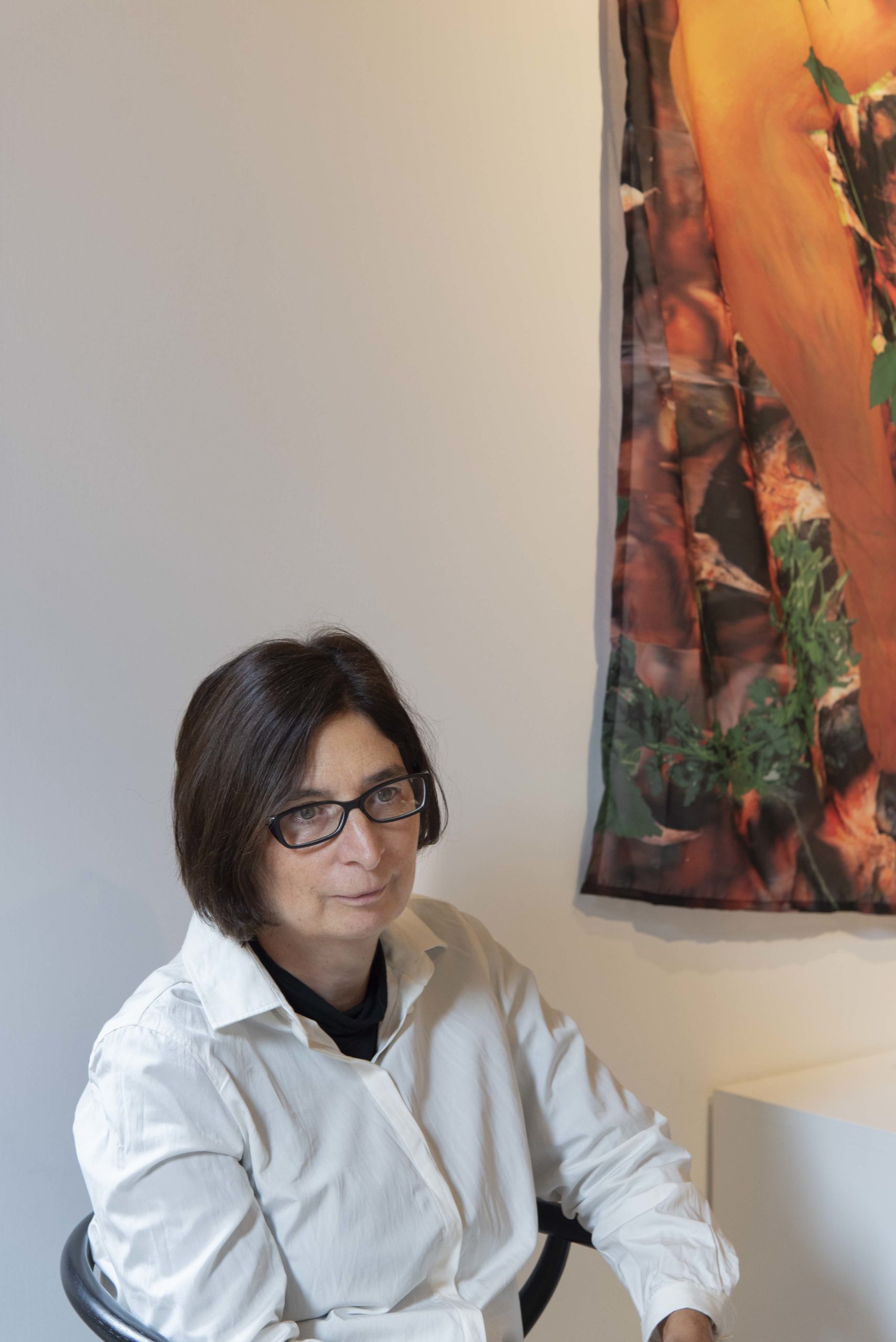
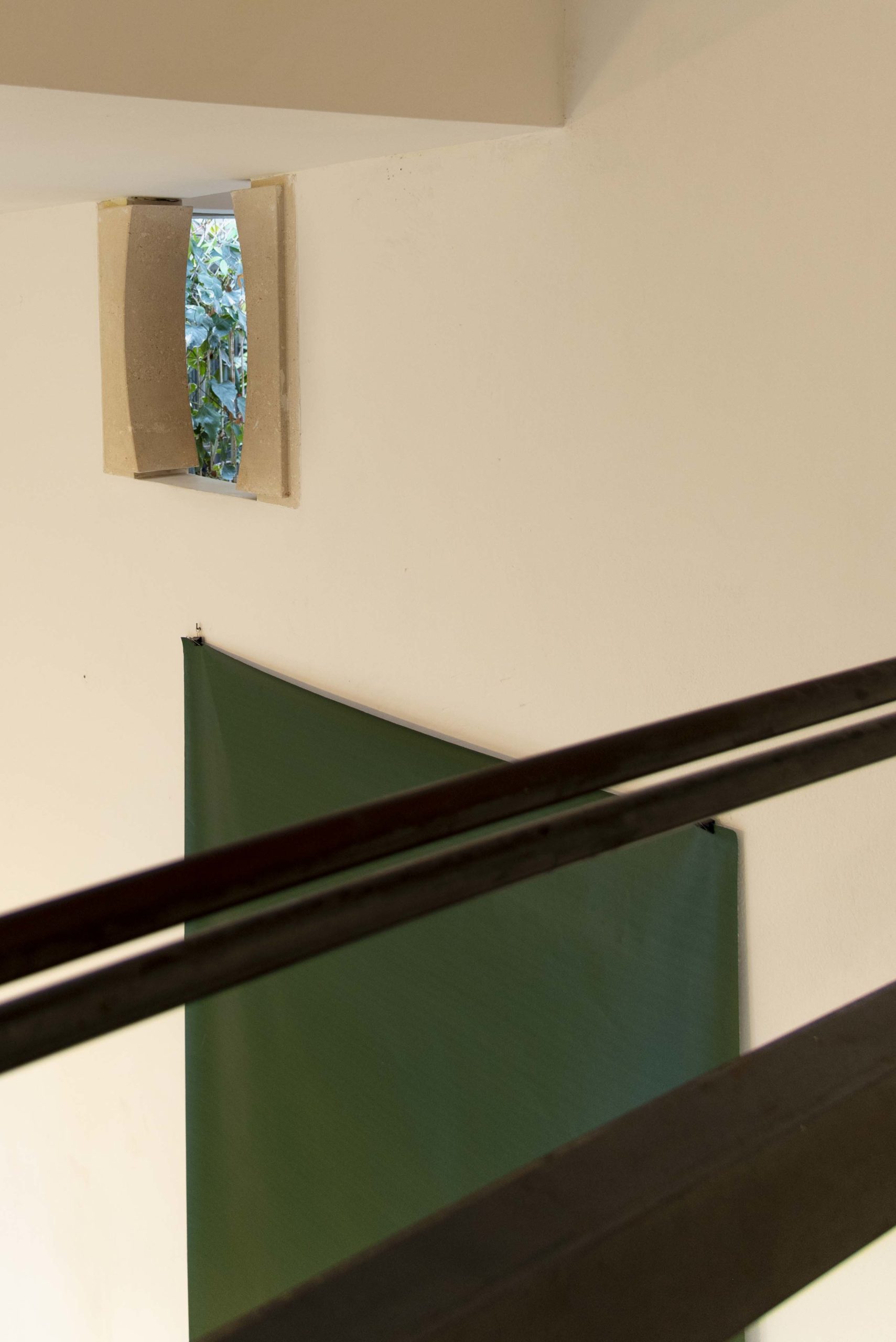
Above left: Aurora Fonda
Above right: a detail of Alma Zevi’s artist residence
Aurora Fonda: Communication is fundamental. The problem is that Venice lives or lived off the fat of the land… but now it should make a little effort, a new restyling, structured and designed in relation to the changes to be implemented in and for the city. The high tide and the pandemic have highlighted all the criticalities and weaknesses of Venice, and I think it will be difficult for everything to go back to the way it was before. For this reason, alternatives should be found to support different economies. For example by encouraging interesting initiatives such as the International Glass Week, which revolves around local excellence, an event that also involves the whole city, various institutions…
Alma Zevi: …and brings together a local aspect – the Murano glass – and international artists who have worked with glass. It makes sense.
Aurora Fonda: And there is also a far-sighted vision there because the glass economy is not only linked to tourism but is also a form of art. It represents a way for artists to discover the potential of the material, update it, and revitalize it. An initiative like this should only grow. Events like these are important for the city, and it is essential that they have the right resonance as there are many glass lovers around the world.

Above left: Alma Zevi
Places of the heart in Venice.
Alma Zevi: I often go to Il Palazzo Experimental, I like staying at the Zattere, it is a somewhat special and unique place in Venice; and then at Schiavi for a drink!
Aurora Fonda: In Venice there are various clubs, depending on where you are: if you are in Cannaregio you go to Vino Vero, if in Dorsoduro you go to Schiavi, in Campo Santa Margherita you go to Bifora.
Alma Zevi: I really like La Zucca!
Aurora Fonda: I like it too!
Alma Zevi: You always eat well there!
Aurora Fonda: On the other hand, as far as art spaces in Venice are concerned, I always really like visiting artist studios. It is always a great experience when you have the opportunity to be with them, smell the paint, the materials, confronting these spaces is stimulating.
Alma Zevi: For me too, and then the Ocean Space. The exhibition they have now, “Territorial Agency”, is very interesting; their programming is always in dialogue with the events that are happening on a global level, plus the Church that hosts it is beautiful and I like the contrast that is generated with contemporary works. And I really like that area of Castello.
Aurora Fonda: Yes, the whole San Lorenzo area up to the Biennale is very beautiful.
Alma Zevi: In fact, when people come to visit the city I take them there, and eat ice cream at Mela Verde… and then I take them to Covo or Covino…
Aurora Fonda: Yes it is a wonderful area!
Alma Zevi: But my favorite place in Venice is my home…
Aurora Fonda: Venice is a somewhat particular place where everyone feels at home, but where paradoxically not even the residents feel at home because it transforms and changes so often it becomes unrecognizable.
